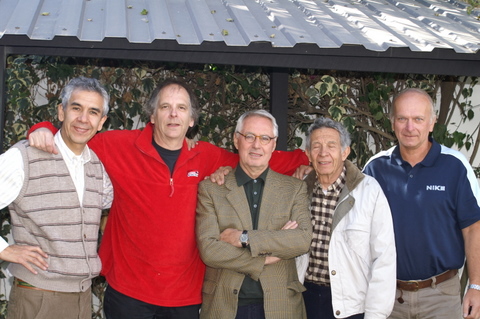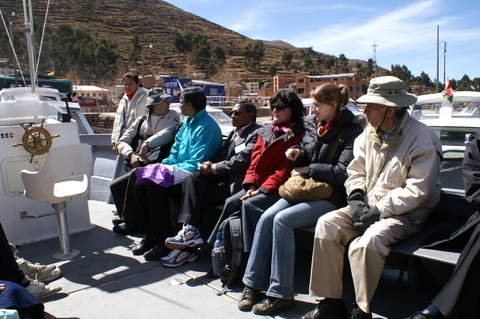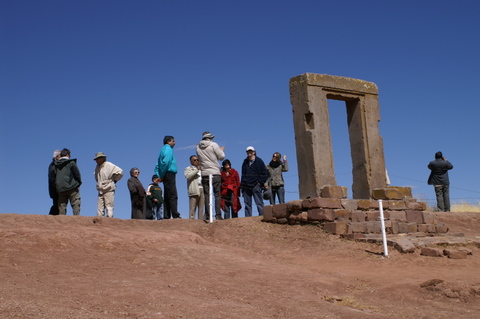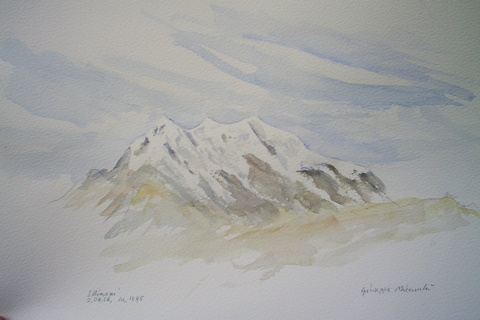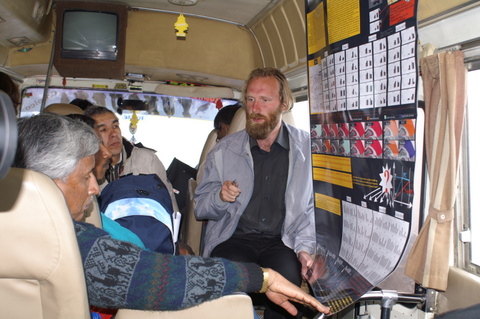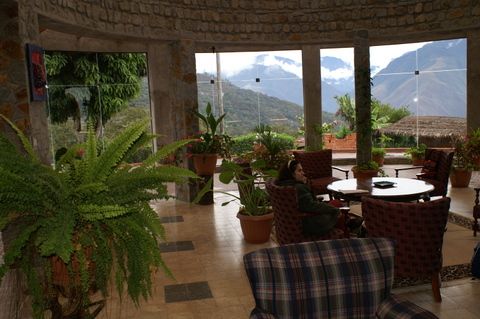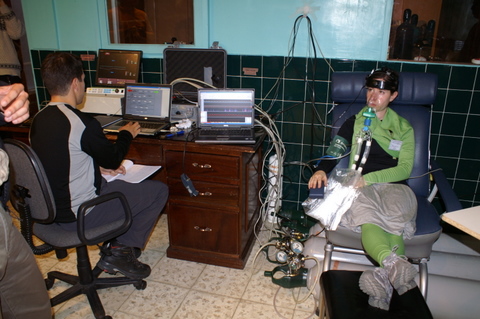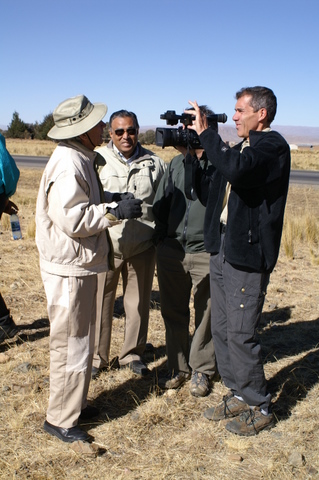|
II SYMPOSIUM THE EFFECT OF CHRONIC HYPOXIA ON DISEASES AT HIGH ALTITUDE |
||
Aug 2 - 9 , 2008 La Paz - Bolivia Post Symposium follow-up |
||
|
|
| Download Advertising |
|
High Altitude
Pathology Clinica IPPA |
First Symposium Follow-up |
From
the organizers of the
First
World
Congress on High Altitude Medicine
and Physiology
and the
First Symposium on the Effect of Chronic Hypoxia on Diseases at High Altitude
High
Altitude Pathology Institute
&
Zubieta
University
and the support of UNESCO
Prof. Gustavo Zubieta-Castillo
Chairman
Prof. Gustavo Zubieta-Calleja
Scientific Committee
Michael Moretti
Anthropologist
Prof. Jorge Asín
International Relations
Prof. Venkatesh Thuppil
Member Organizing
Committee India
K.S. Parthasarthy Partha
Member Organizing Committee
India
Lic. Nancy Zubieta
Coordination
Dr. Luis Zubieta-Calleja
General Assistance
Maria Eugenia Quiroga
Multiple support
Clotilde Calleja
Nutrictionist advice
Jack Loeppky
Ideas and assistance
Rafaela and Natalia Zubieta
Web contact support
Shirley Mendieta
Coordinacion general
This follow-up of the II Chronic Hypoxia Symposium will give insight into the actual event and how it evolved. It had a unique style since it was an itinerant meeting where the conferences were carried out in different cities and environments in order to show our visitors life at high altitude.
Welcome Speech
There are no stars in this meeting. We are all a constellation of the most distinguished scientist dedicated to the problems of physiology and hypoxia.Unfortunately some could not arrive to join us for different reasons.In this meeting you will be free to express your opinions without any restriction. For more time to expose your ideas please ask if it is possible.
We are living this moment, with many socials and political problems in a geologically unstable planet. Nevertheless we are all dedicated to science, working intensively in our laboratories, in order to help humanity, struggling to improve its health and save lives.In many countries of the world, the most prominent scientists have worked in environments surrounded by irrational social behavior. Throughout history there are several examples, as in the First and Second World War. In this moment, in our country Bolivia there is a big political struggle, but we keep walking.
We here in this city and in our laboratory, the one thing we can surely offer you is, hypoxia. And maybe you may gain a new experience in this factor, which triggers many diseases acutely or chronically.Life is a big mystery, bigger that the cosmos, which seems only to follow very few physical laws compared to the complexity of life. Biology and life seem more complicated and scientists can only pick up very little things. Yet these are very close and near our hands.
With theses simple ideas, I wish you all a pleasant and happy stay in this II Chronic Hypoxia Symposium. We thank all of thos that collaborated to carry out this symposium, including The High Altitude Pathology Institute, UNESCO, Zubieta University and all the excellent people that gave their work for the success of the Symposium
Prof. Dr. Gustavo Zubieta-Castillo
Conferences in La Paz on Monday
The conferences started on Monday with the Welcome Speech by Gustavo Zubieta-Calleja (Sr) at the 1st floor of the Zubieta University building in the auditorium.
Frantisek Kolar from Czech Republic gave a stimulating opening talk Protection Of The Heart Against Ischemic Injury Conferred By Adaptation To Chronic Hypoxia, where he concluded that “hypoxia per se appears to be responsible for the induction of the protected cardiac phenotype of Intermittent Hypobaric Hypoxia rats”, there-by ruling out that the re-oxygenation phase would play a role.
Dipak Das from USA gave a detailed talk on Hypoxic Adaptation Protects Cardiac Cells Through Autophagy, and he summarized “cardiac protection elicited during hypoxic adaptation is mediated at least in part via upregulation of autophagy in association with Bag-1 protein”.
Poul-Erik Paulev from Denmark was represented by Gustavo Zubieta-Calleja (Jr) in Breath-Hold Diving And Decompression Sickness. The conclusion was “We have developed a dive table that may protect against decompression sickness, but its validity has to be evaluated in practice. The danger is increased in mountain lake free diving, where breath-hold diving has not yet been practiced but will probably be done in the near future.”
Luis Zubieta-Calleja from Bolivia presented Does Breath Holding Time Increase With Adaptation To High Altitude? “The respiratory center’s breath holding time is not influenced by a normal acute adaptation exposure to a fixed high altitude and it is linked to the immediate adaptation of the organism to a lower PaCO2 at high altitude.”
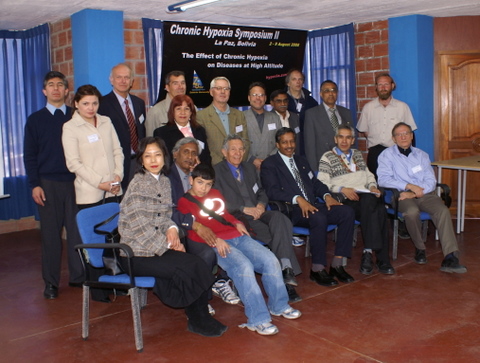
Back Row: Luis Zubieta-Calleja, Maria Eugenia Quiroga, Frantisek Kolar, Frank Tessier, Giuseppe Miserocchi, Larry Silver, Virupaksha Hosur , Luc Teppema, Dipak Das, Sergei Stroev. Middle Row: Maria Eugenia Quiroga, Elydia Mujica. Front Row: Yuki Ishihara, Thuppil Venkatesh (Luis Andres Zubieta Quiroga), Gustavo Zubieta-Castillo, Babu Govind,, Gustavo Zubieta-Calleja, Joe Fisher. (All photos courtesy of Frantisek Kolar).
Then the talks went on all day stopping for lunch at 12:00 where we all gathered at the cafeteria on the fifth floor of the Zubieta University building. The sun was very bright sitting on an intense blue sky.
Luc J. Teppema from The Netherlands exposed on Acetazolamide (AZ) And Hypoxic Ventilatory Response. Are The Carotid Bodies Inhibited? Where he concluded “at the dose applied AZ has no inhibitory effect on the carotid bodies and that the arterial H+ concentration as such has no predictive value as to the magnitude of the Acute Hypoxic Ventilatory Response.”
Gustavo Zubieta-Calleja (Jr), Luc Teppema, Guiseppe Miserocchi, Gustavo Zubieta-Castillo (Sr) and Frantisek Kolar.
Joe Fisher from Canada presented two interrelated talks: The Oxyhemoglobin Dissociation Curve In Vivo. Part 1: Gaining Control Of Po2 And Pco2 Independently Of Each Other And Independently Of Minute Ventilation and The Oxyhemoglobin Dissociation Curve In Vivo. Part 2: A Field Test Of Acclimatization And Adaptation To Altitude? He amply described his new techniques of study that were being carried out in multiple tests at the High Altitude Pathology Institute by all his team during the conferences. His conclusion “Our data showed that at 4700 m the contribution of hyperventilation to the increase in SpO2 is primarily due to an increased alveolar PO2 and to a lesser--but still significant--extent, the left shift of the ODC. However, at greater altitude, the relative contribution of these factors will likely be reversed.”.
Gustavo Zubieta-Castillo (Sr) from Bolivia talked about The Ventilatory Hyperoxic Shunt Test At 3510 M. There was a stimulating discussion on all the subjects exposed. This new technique allows for a precise measurement of pulmonary shunts at high altitude, particularly in CMS.
The afternoon talks ended with the poster presentations.
Elydia Mujica from Peru presented a poster Aerobic Capacity In Coca Chewerswith the conclusion that “there was no difference in the aerobic capacity (VO2max) in coca chewers and non-coca chewers”. She also presented another poster Reproductive Hormones In Pregnancy At High Altitude and concluded “There are no differences between Progesterone and FSH during pregnancy at high altitude and sea level”.
The welcome Dinner started at 19:00 hours and everyone enjoyed the warm environment, the great food and the fantastic company.
The Titicaca Lake at 3800 m on Tuesday
We started at 8:00 am up to El Alto, the high plateau city bordering La Paz, at 4100 m (where the highest commercial airport in the world is located). After 45 minutes of riding through the altiplano we reached an area where the Cordillera of the Andes with several of its mountains in chain visible in the horizon stimulated Prof. Guiseppe Misserochi to sit on the floor, take out his water colors and paint with master strokes the breathtaking view in around 10 minutes.
The group at the high altitude diving instruction center (CIBA) at Titicaca Lake
Upon arrival to Tiquina, the strait in Lake Titicaca around 1 hour and 45 minutes from La Paz, we were received by the Bolivian Navy officers and transported across in roughly 10 minutes to the Centro de Instrucción de Buceo de Altura (High Altitude Diving School). There we heard a talk regarding their experience with high altitude diving and their climb to the volcano Licancabur where dives were performed at 5916 m. The installations were shown and the high altitude diving tables developed by Poul-Erik Paulev and presented during the first Chronic Hypoxia Symposium, were discussed.
Shirley, Gustavo Zubieta-Calleja, Babu Govind,Virupaksha Hosur , Winny Teppema, Sarah Teppema, Gsuavo Zubieta-Castillo.
We again crossed the strait and headed back to the Hotel Titicaca, where we had a camaraderie lunch in a restaurant where through the windows, the strong blue Titicaca Lake was surrounding us. After lunch and a short walk around, the conferences were continued with that of
Vidyasagar Casikar from Australia talked about Does Chewing Coca Leaves Influence Physiology At High Altitude? Several conclusions were reached but noteworthy is “The coca chewers had lower levels of glutamate compared to controls. Glutamate is the basis for many neurotransmitters and is the product of amino acid metabolism. This is an indication of reduced oxygen utilization”.
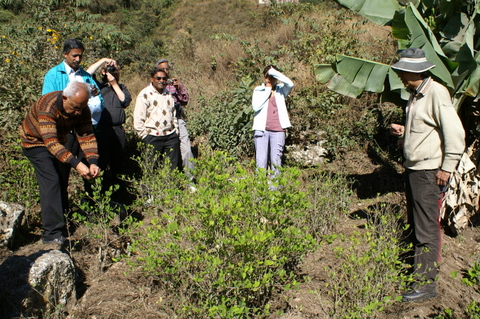
Vidyasagar Casikar sampling at the coca leaves plantation in Coroico.
A video of the soccer game played at 6542 m on the summit of Mount Sajama was also showed and commented on the importance of such a game in relation to the theory of Gustavo Zubieta-Castillo on the possibility of adaptation to live at the altitude on the summit of Mount Everest.
Returning to La Paz, in the evening we had a nice cocktail with a small buffet at the residence of Prof. Dr. Gustavo Zubieta-Calleja and his wife Lucrecia De Urioste. Wines, cheese and different delicatessen were served.
The trip to Tiahunacu at 3800m on Wednesday
The Tiahuanacotas were an ancient indigenous civilization that left only the ruins that are considered a treasure as they are gradually being discovered and are world tourist attraction. The Astrological aspects, around which these temples were built, having the Puerta del sol “Sun Door” as its principal attraction, are most intriguing. After the exciting morning tour, the afternoon talks were resumed at Zubieta University back in La Paz.
One of the monuments dating back over 2000 years at Tiahuanacu
Giuseppe Miserocchi from Italy showed us in his presentation on Cardio-Pulmonary Response And Lung Interstitial Fluid Dynamics In Chronic Hypoxia, novel techniques on the study of intra-pulmonary pressures and concluded “We hypothesize that in chronic hypoxia, capillary compression by tissue forces may cause an increase in microvascular resistance that may contribute to the steady increase in pulmonary artery pressure.”
Gustavo Zubieta-Calleja (Jr) from Bolivia presented his work on The Adaptation Of Highlanders To Sea Level. . The high altitude adaptation formula previously described:

was discussed and also referred to residents going to sea level. Upon ascent to high altitude 11.4 days per every km of altitude are required for a hematologic adaptation.
The Talks in Chacaltaya at 5300 m. on Thursday
After one hour drive from La Paz to Chacaltaya, the highest ski slope in the world, (hardly usable now due to global warming) through an intricate road up the mountain. Several colleagues walked up the steep trail to the summit. This was the first day that was cloudy and Huayana Potosi Mountain was hardly visible. Upon their return to the Refuge in the Chacaltaya hut, the conferences were continued with that of Prof. Babu Govind first. The Cafeteria was improvised and a projection screen and Data Show were setup. Some tourists that were around joined in and found it very amusing. This is most probably a world record for conferences on the highest point on planet Earth.
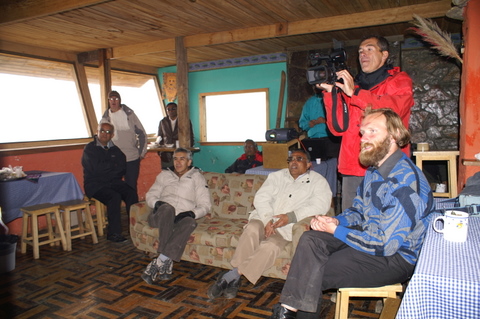
Babu Goving giving his talk in Chacaltaya at the Refugio of the Club Andino (5220 m)
Thuppil Venkatesh from India presented Usefulness Of Biochemical Markers In The Evaluation The Effect Of Pranayama During The Management Of Chronic And Acute Mountain Sickness where he concluded “It is proposed to use this simple pranayama technique to simulate various physiological processes and keep tracking the levels of various biochemical indicators or markers to prevent the deleterious effects of mountain sickness”.
Govind Babu from India talked about Acute Mountain Sickness – Can It Be Predicted? Where he concluded that “The Na+ - K + levels have no predictive value, The test of capillary fragility is deranged or down regulated and is a sensitive AMS predictive tool.”
The last conference was a presentation by Vadim Beresovbski from Ukraine. Regarding the two faces of hypoxia. One that is used for healing as in the case of the hypoxicator used by the Ukranian colleagues at the Bogomoletz Institute at Kiev, in order to treat Asthma, circulatory disorders and other disease and the opposite face of hypoxia shown by acute exposure to altitudes above of 2000 m where Acute mountain Sickness is presented. Prof. Beresovski was not able to come so his presentation was simply exposed.
The closing dinner at the Zubieta University Cafeteria was carried out on the evening. A film Vuelve Sebastiana by Jorge Ruiz regarding the Chipayas, was presented. The ISCH last meeting was carried out and then we enjoyed a great buffet, wine and drinks. Guiseppe Miserocchi kindly offered the organizers his watercolor painting of the Illimani (shown below).
An oil painting by Gustavo Zubieta-Castillo (Sr) was raffled and the winner turned out to be Guiseppe !!
Poul-Erik Paulev was distinguished as the 2008 "Science, Honor and Truth" Medal recipient.
The trip to Coroico and the conference in the bus at 4300 m. on Friday.
The trip to Coroico started by a ride up from La Paz to the cumbre the high crossroad at 4500m. The transportation bus, after 20 minutes of the climb, broke down. As we waited for the replacement bus to arrive in half an hour, Sergei Stroev, pulled out his poster and in a pleasant and friendly environment we began to hear of his work regarding his new technique to study acclimatization in rats. This is probably also a world record of a talk in a bus on a high mountain.
Sergei Stroev giving his conference in the bus at 4500 m on the cumbre crossing during the trip to Coroico.
Sergei A Stroev from Russia talked on Expression Of Endogenous Antioxidants In Rat Hippocampal Neurons After Four Kind Of Hypobaric Hypoxia Modeling The High Altitude. His work was extensively discussed and he concluded that “The effect of hypoxia on the expression of Cu, Zn-SOD, Mn-SOD, Trx-1 and Trx-2 was studied in rat hippocampal fields CA1, CA2, CA3, DG. The changes in expression were studied by immunocytochemistry.”
The unique environment of the talk was most stimulating and several questions were asked. As the new bus arrived, we interrupted his talk to be later continued. The climb up the paved sinuous road continued and gave rise to a great change from the snow peaked mountains and hypoxia down, down, down a descending road to relative hyperoxia at 1800 meters in the tropical rainforest full of vegetation and birds and flowers. Several stops were made for site seeing and Sergei Stroev and Frantisek Kolar both avid and practically professional photographers relished in delight of the steep mountain canyons that ended below in a clear water river, surrounded by very green plants and full vegetation. The sweet scent of tropical lands was already stimulating our olfactory sensations.
Upon arrival at the Hotel Coroico, we gathered in a glass-surrounded living room,
Lucrecia De Urioste at The Hotel Coroico.
where the pool was clearly visible, and Sergi Stroev continued with his talk, while we had a cold beer. The technique he described was again profoundly discussed.
The creation of the International Society of Chronic Hypoxia (ISCH)
All the attendants gathered after the meetings and discussed the possibility of creating the ISCH. The enthusiasm and the flow of ideas were intensive. In the first meeting, it was decided that such a society was indeed a necessity considering that the high altitude should not only be studied in its acute effects but rather also in the chronic ones, since man will travel to hypoxic environments and will stay there for longer periods. Furthermore, high altitude residents will greatly benefit from the knowledge and expertise gathered through such a society.
In the second meeting the name of the society was amply discussed with many suggestions all flowing in a democratic and stimulating environment. Finally the Acronym ISCH was adopted.
The final meeting held during the closing dinner, gave rise to the first directing committee appointing Larry Silver as President and Gustavo Zubieta-Calleja (Jr) as Vice-President and Alexandra Mardimae as Secretary, who actually carried out all the meetings memoirs. All other colleagues and attendants were appointed to the board of Directors and they compromised their cooperation. This was shortly after carried out by Thuppil Venkatesh in India by contacting the WHO, UNESCO and other organizations informing them of these events.
Joe Fisher's team research
One of the first groups to arrive to La Paz was that of Joe Fisher and his team of students and collaborators from the University of Toronto. He setup all his equipment in the laboratories at the High Altitude Pathology Institute and immediately upon arrival started his studies of adaptation in themselves and later in other high altitude residents. These were two groups of research, one studying the oxygen dissociation curve “in vivo” and the other respiratory center response. Collaterally, cerebral blood flow was also studied through a transcranial doppler technique and carotid body echodoppler studies. The preparation and the setup of the equipment were complex and not exempt of difficulties, that were ingeniously solved by the enthusiastic team. They carried out the research throughout the whole meeting.
During one of the "In Vivo" Oxygen Dissociation Curve studies
Reporting for Extreme Cities
Frank Tessier, a reporter (and also a PhD in Physiology) for Zadig Productions in France, attended the whole meeting and filmed the presentations and discussion throughout the meeting, as he was preparing a scientific television report on life in the highest large city of the world, La Paz located between 3100 and 4100 m. that will be presented throughout Europe.
Frank Tessier in one of his multiple interviews on the road to Lake Titicaca.
CONCLUSION
The environment of this 2nd Chronic Hypoxia Symposium was relaxed, scientifically democratic and highly productive and stimulating. Several scientific cooperation strategies were carried out between different countries. Zubieta University and the High Altitude Pathology Institute clearly expressed that it had all its doors open for research associations in the near future. We have just learned that Frantisek Kolar from the Czech Republic and Guiseppe Misserochi from Italy have stablished a cooperative program of research. More on high altitude medicine and physiology will come in the near future.
|
contact: zubieta@altitudeclinic.com |
|


